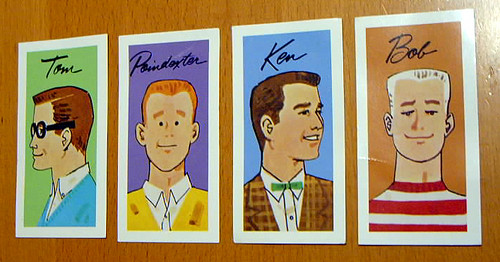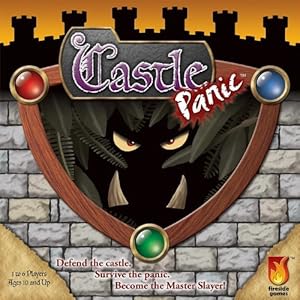 Game Theory
Game Theory  2 Comments
2 Comments Any Way She Wants
Social media is afire after the latest Anita Sarkeesian video resulted in renewed rape/death threats against her. Sarkeesian makes the seemingly uncontroversial statement that women’s bodies are abused and killed for little or no reason in video games. As a result, some men are so enraged that they’re driven to hurl sexist, violent abuse at the very idea of women who come within fifty feet of a game.
The problem with that is that I am a woman gamer. So are many of my women friends. Many of them run games for their friends, and a growing number are designing their very own games. I am wildly proud to be included in all this. Many of those friends have written wisely about the unfettered misogyny and racism that plagues the electronic and tabletop game industries at the same moment when we see more women and people of color entering the hobby than ever before.
So I don’t have much to add to their insightful commentary. But I do want to say this to my fellow women in games:
Play whatever games you want.
Yes, of course that means the button-mashing robot invasion game, or the minmaxed mecha pilot, or the Napoleonic cavalry officer trying to win Waterloo. War games and LARPs and Minecraft and Burning Wheel–all of it belongs to you as much as anyone else in the world, and don’t let a soul tell you otherwise.
But you can also play the magical space princess romance game. You can play a game where the only measurable objective is to get the boy (or the girl). You can play a game that’s all about middle school gossip. You can play a game with no boys allowed.
You can play games with fluid, barely there rules, and super-crunchy tables of staggering detail.
You can play games of scientific discovery, and life in the military, and the pursuit of katana mastery, and young love.
You can play games of death-defying feats and fearless daring, where you do everything you can’t ever imagine doing in the real world.
You can play games with sex: grand, towering, chandelier-swinging heights of passion that include superhuman flexibility and magical potions of endurance.
You can play games where you get to hunt down and beat the shit out of your rapist.
You can play games that capture a perfect, impossible childhood with nothing scary at all.
Because games contain everything we are–right now, fragile, flawed, unfinished–and everything we could possibly be–brave, magnificent, powerful, unstoppable. So nothing is beyond the scope of games. If you use a game to tell your story, there’s a very good chance that it’s a story others want to play too.
Because these games exist in the dimensions of ourselves and our world, the dark things do creep in: racism, sexism, ableism, bullying, abuse. Some of that is unintentional, but we’re coming to grips with the reality that others don’t always see these things as a problem. Some even see it as a solution, a boundary fence to protect an imagined definition of games that’s confined only to their tiny vision.
Games are bigger than these people. Protecting our games from criticism smothers them until all the fire goes out. Improving games improves us all, and the world we play them in.
And nobody gets to say your game is less worthy because of what you want to play. You are participating in one of the oldest common human experiences in the world. Play it all, women. Play all the games, then make your own.

 This year, I’m trying to do something about this. I’ve submitted proposals to both Origins and Gen Con–the two conventions I’m planning to attend this year–to establish a Sensory Break Room for people who are physically or mentally challenged by the rigorous environment of the con.
This year, I’m trying to do something about this. I’ve submitted proposals to both Origins and Gen Con–the two conventions I’m planning to attend this year–to establish a Sensory Break Room for people who are physically or mentally challenged by the rigorous environment of the con. The room will be screened off, instead of requiring users to open and close a clanky door. The lights will be kept quite low, probably too low to read properly, but there may be some soft, shifting colored lights to focus on. No music or other noise will be permitted, but a small fan or ionizer will run to provide white noise as an auditory buffer. Nobody will bug anyone else, but neither is it a nap room. If someone falls asleep, the monitor will wake them up after five or ten minutes, and each user will be responsible if they accidentally sleep through an event they’re supposed to attend. I’m hoping that the folks most likely to use it will be generous in bringing some adaptive tools to share–weighted blankets, exercise balls, fidgets, and other comforting objects.
The room will be screened off, instead of requiring users to open and close a clanky door. The lights will be kept quite low, probably too low to read properly, but there may be some soft, shifting colored lights to focus on. No music or other noise will be permitted, but a small fan or ionizer will run to provide white noise as an auditory buffer. Nobody will bug anyone else, but neither is it a nap room. If someone falls asleep, the monitor will wake them up after five or ten minutes, and each user will be responsible if they accidentally sleep through an event they’re supposed to attend. I’m hoping that the folks most likely to use it will be generous in bringing some adaptive tools to share–weighted blankets, exercise balls, fidgets, and other comforting objects. 
 I know the Internet is designed to inspire fury. That hasn’t been the majority of my experience with it, but lately, it seems determined to correct my underestimation of its rage-inducing qualities.
I know the Internet is designed to inspire fury. That hasn’t been the majority of my experience with it, but lately, it seems determined to correct my underestimation of its rage-inducing qualities. PROBLEM #3: HE THINKS THERE’S ONLY ONE WAY TO PLAY WITH TOY CARS. This one particularly burns my ass, because I know from experience that he’s wrong. When I was a kid, I played with toy cars by lining them up in perfectly symmetrical, parallel rows, sorted by shape, size, and color. Then my sister would walk through the lines like Godzilla, kicking them to kingdom come. And then I would line them up again in different patterns. I picked my favorites by the way they felt in my palm, my closed fist.
PROBLEM #3: HE THINKS THERE’S ONLY ONE WAY TO PLAY WITH TOY CARS. This one particularly burns my ass, because I know from experience that he’s wrong. When I was a kid, I played with toy cars by lining them up in perfectly symmetrical, parallel rows, sorted by shape, size, and color. Then my sister would walk through the lines like Godzilla, kicking them to kingdom come. And then I would line them up again in different patterns. I picked my favorites by the way they felt in my palm, my closed fist.
 1)
1)  2)
2)  3)
3)  4)
4)  5)
5)  6)
6)  7)
7)  I came again the next year, and the whole world had changed. TSR was under siege, in their four-story castle in the center of the dealer’s hall, but there were sappers among us in the crowds, skulking around in clown white and satin capes.
I came again the next year, and the whole world had changed. TSR was under siege, in their four-story castle in the center of the dealer’s hall, but there were sappers among us in the crowds, skulking around in clown white and satin capes. 

 I saw the Darling Husband’s hackles rise as he read, though he channeled it into humor, since the therapist who gave us the papers wasn’t the one who did the evaluation. Instead, he suggested that they give the doctor a call and tell him
I saw the Darling Husband’s hackles rise as he read, though he channeled it into humor, since the therapist who gave us the papers wasn’t the one who did the evaluation. Instead, he suggested that they give the doctor a call and tell him 
 But she was right. Nicolas was a real live French gamer guy. I thrilled him in our first meeting by having Secret Knowledge. We were talking about TV shows, movies and books we liked, and he asked if I watched “Aux Frontières du Réel,” or “On the Frontiers of Reality.” I said I didn’t know it, was it French? “Non, non,” he insisted, and reached for a book. The cover explained it all—behind the French title was a distressed, typewriter-style X. “Oh,” I explained in French, “In America it’s called ‘The X-Files.’” “That explains everything!” he exclaimed. “I always wondered why that X was there!”
But she was right. Nicolas was a real live French gamer guy. I thrilled him in our first meeting by having Secret Knowledge. We were talking about TV shows, movies and books we liked, and he asked if I watched “Aux Frontières du Réel,” or “On the Frontiers of Reality.” I said I didn’t know it, was it French? “Non, non,” he insisted, and reached for a book. The cover explained it all—behind the French title was a distressed, typewriter-style X. “Oh,” I explained in French, “In America it’s called ‘The X-Files.’” “That explains everything!” he exclaimed. “I always wondered why that X was there!” I’d only seen Doctor Who played by Tom Baker on PBS, when I was about five years old. What I’d seen, I didn’t really remember, except, of course, the scarf, and several aliens that looked like upended rubbish bins on wheels. I’ve become a rabid fan since the 2005 reboot, and there’s no doubt I would’ve enjoyed the game more, knowing what I know now.
I’d only seen Doctor Who played by Tom Baker on PBS, when I was about five years old. What I’d seen, I didn’t really remember, except, of course, the scarf, and several aliens that looked like upended rubbish bins on wheels. I’ve become a rabid fan since the 2005 reboot, and there’s no doubt I would’ve enjoyed the game more, knowing what I know now.